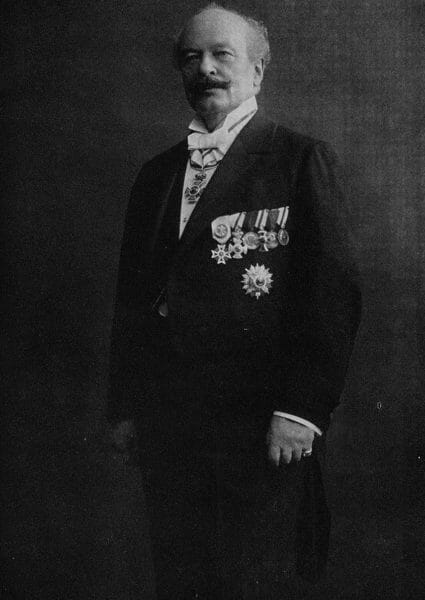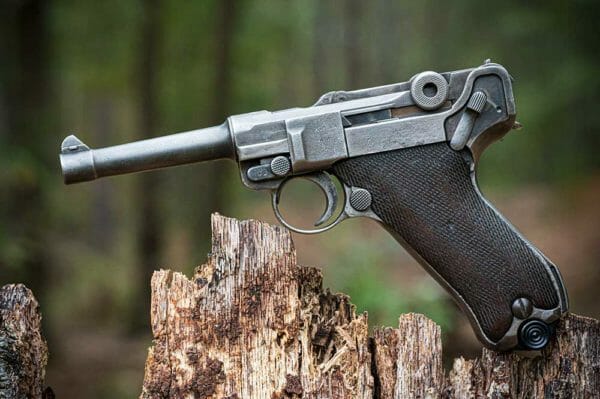Logan digs deep into the development of the 9mm Luger cartridge. Is this the most produced pistol round in history?
U.S.A. -(AmmoLand.com)- The 9mm Luger cartridge is, arguably, the most popular and adaptable cartridge to come out of the 20th century. To take it a step further, it might be the most popular handgun cartridge of all time. Up until very recently, the 9mm cartridge could be found literally everywhere for less than a quarter apiece. Now, they’ve become harder to find than an honest person in Washington.
To help ease the ammo hardship, one lucky AmmoLand subscriber is going to win 5,000 rounds of Blazer Brass 9mm 115-grain FMJ ammo. We’ll tell you how you can win in a minute, but first, what do you really know about the history of the round? In 1902, Austrian arms designer Georg Luger created the new cartridge for DWM to compliment the semi-automatic pistol that they were making that also just so happened to bear his name.

Nothing ever happens in a vacuum, and all new creations come to be by standing on the shoulders of things that came before them. Georg Luger was no exception to this. He came up with the 9x19mm cartridge by altering his previous 7.65x21mm cartridge that was introduced in 1898.
That cartridge owed its development to an even earlier design: the 7.65x25mm Borchardt, which was developed by Hugo Borchardt for use in his C-93 semi-automatic pistol. Like every proud parent of an ugly child, Hugo thought his gun was great. Unfortunately, anyone not related to him felt otherwise. Sales languished and the guns sat as surplus for about 20 years.
Borchardt’s pistol and cartridge were reworked by Luger to create the first version of the pistol that would bear his name in the 7.65x21mm cartridge, but the Germans were anxious to adopt a larger caliber sidearm.
Luger set to work designing a new cartridge and redesigning his pistol to match it. He removed the bottleneck shape from the cartridge and created a tapered, rimless design. The result was the 9x19mm Parabellum. Or, the 9x19mm Luger, 9mm Luger, 9mm Parabellum, 9mm NATO, or, what most of us simply call the 9mm.
The cartridge was submitted for testing to the British Small Arms Committee in 1902 and to the US for tests at Springfield Armory in Massachusetts in 1903. The following year, an additional 50 pistols and 25,000 rounds of 9mm ammo were sent to Springfield for more serious testing.

The German Navy adopted the new cartridge in 1904 and the German Army followed suit four years later in 1908. That date provided the name most often associated with the adopted pistol: the Luger P08. Unlike the Germans, the US would, ultimately, choose the .45 ACP cartridge in March 1911 and ignited a caliber war that still rages today.
The idea of developing a variety of different bullet types and grain weights was not something that waited until the cartridge’s popular adoption. Instead, it happened fairly quickly.
For example, in the years before World War I, DWM manufactured truncated hollow point bullets for use by colonial troops in Africa.
During World War I, Germany’s earliest 9mm loads used 124-grain FMJ bullets with truncated noses. By 1915, they had switched to 115-grain FMJ bullets with round noses.
Before getting too far into the 20th century, we have to address the 19th-century elephant in the room: the Hague Convention of 1899. This “meeting of the minds” resulted in a treaty with three major declarations, the final one stating that signatory nations agreed to a “Prohibition of the Use of Bullets which can Easily Expand or Change their Form inside the Human Body such as Bullets with a Hard Covering which does not Completely Cover the Core, or containing Indentations.”
In plain terms, this was meant to prohibit the use of soft-point bullets, which had a partial metal jacket and an exposed soft tip, as well as rounds with incisions in the tip to aid in expansion. The latter is, of course, a distant cousin to the modern hollow point round. This prohibition would limit signatory states to ball ammo.

Countries that participated in the Convention agreed to these declarations and signed on the dotted line … with one big exception: the United States signed part, but not all, of the document. Most notably, we did not sign the portion that limited the type of ammo that could be used.
So, no, the US was not bound to use ball ammo by the Hague Convention, simply because we didn’t sign that part of it. Even if we had, it wouldn’t have mattered much anyway. Germany signed the declaration that forbid use of projectiles whose sole purpose was to spread asphyxiating poison gas, but they made quick use of such weapons (followed quickly by plenty of other countries) in World War I.
Alright, moving on!

After World War I, the caliber’s popularity picked up some steam with the widespread development of the machine pistol (or, submachine gun), most of which were chambered in 9mm. Both semi-automatic pistols and submachine guns chambered for 9mm Parabellum were introduced in Belgium, Bulgaria, Czechoslovakia, Finland, Poland, Sweden, and Switzerland all before World War II.
During World War II, Germany attempted to conserve lead by introducing rounds with iron cores encased in lead. They were identified by a black jacket to begin with, but by 1944 had become the standard, so the colored jacket was discontinued.
At the same time, the Germans also developed a 150-grain FMJ bullet with subsonic properties for use with silenced weapons.

The North Atlantic Treaty Organization, better known simply as NATO, was formed in 1949. In 1955, they adopted the 9x19mm cartridge as its official sidearm cartridge. This made sense as many of the member nations were already fielding sidearms chambered for the round.
In the coming decades, the 9mm would steadily increase its foothold in the global ammo market. The United States military adopted the Beretta M9 semi-automatic pistol chambered in 9mm in 1985, ending the .45 ACP’s reign after 74 years.
At the same time, law enforcement firearms underwent a dramatic shift away from revolvers in .38 Special or .357 Magnum to semi-automatic pistols. While there has been some adoption of .40 caliber for these purposes, the 9mm has undeniably risen to the top.
A very similar trend was seen in the civilian handgun market. The prevalence of military, law enforcement, and civilian preference for the cartridge has cemented its place in ammo history. By 2013, the 9mm Luger accounted for 21.4% of the entire world cartridge market.
Seven years later, in 2020, the 9mm is more popular than ever before, but recent developments have certainly made it harder to find on physical shelves and in digital shopping carts.
That’s why we’re coming full circle to the beginning of this history lesson. Now that you know all about the 9mm Luger’s history and development, it means you’ll appreciate it all the more if you’re the lucky AmmoLand subscriber who is chosen to win 5,000 rounds of Blazer Brass 9mm 115-grain FMJ ammo.
So, what are you waiting for!? Enter the contest now!
About Logan Metesh
Logan Metesh is a historian with a focus on firearms history and development. He runs High Caliber History LLC and has more than a decade of experience working for the Smithsonian Institution, the National Park Service, and the NRA Museums. His ability to present history and research in an engaging manner has made him a sought after consultant, writer, and museum professional. The ease with which he can recall obscure historical facts and figures makes him very good at Jeopardy!, but exceptionally bad at geometry.


Logan, While this is a topic that I, along with probably many of your readers, am somewhat informed about, I still found it fascinating. The way that you write, and express facts that are somewhat familiar, but not really organized in my mind, in this fashion, really makes me want to seek out some of your other work. Myself, I have had a 1911 in .45 ACP, and while I was able to handle the recoil with ease, since my first centerfire pistol was a P 64, basically a copy of the Walther PPK, only chambered in 9mm Makarov, in… Read more »
STOP the Giveaway popup, I’m already entered.
Very cool. The one thing I would add/alter is toward the end when you mention .40. 9mm rose to the top in the early 80s, with the widespread law enforcement adoption of Glock pistols. .40 did not appear until the late 80’s/early 90’s. .40 was developed for the FBI following their failed adoption of 10mm. That was based on the false narrative about the failure of 9mm in the 1986 Miami/Dade shootout. Now with advances in material and bullet design, and with a better understanding of what actually happened in 1986, 9mm is again the FBI cartridge and has spread… Read more »
I don’t see a method for entering the contest here.